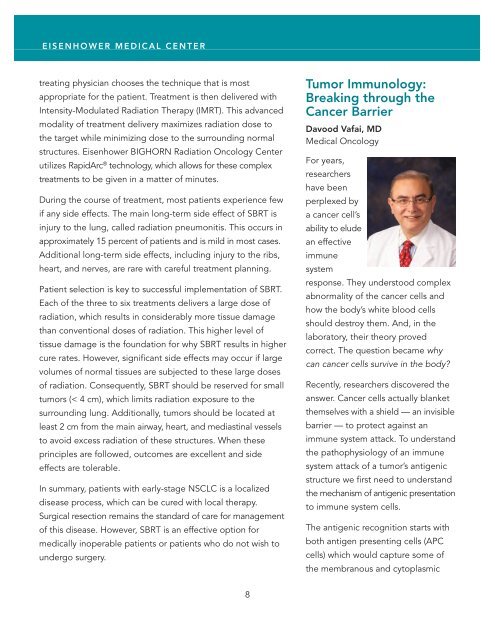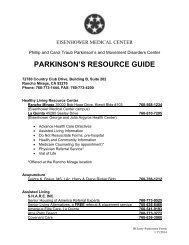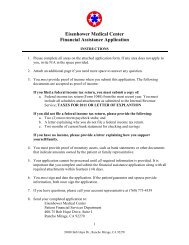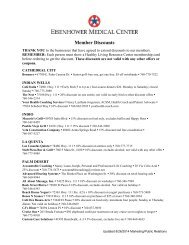Cancer Program Annual Report - Eisenhower Medical Center
Cancer Program Annual Report - Eisenhower Medical Center
Cancer Program Annual Report - Eisenhower Medical Center
You also want an ePaper? Increase the reach of your titles
YUMPU automatically turns print PDFs into web optimized ePapers that Google loves.
E I S E N H O W E R M E D I C A L C E N T E R<br />
treating physician chooses the technique that is most<br />
appropriate for the patient. Treatment is then delivered with<br />
Intensity-Modulated Radiation Therapy (IMRT). This advanced<br />
modality of treatment delivery maximizes radiation dose to<br />
the target while minimizing dose to the surrounding normal<br />
structures. <strong>Eisenhower</strong> BIGHORN Radiation Oncology <strong>Center</strong><br />
utilizes RapidArc ® technology, which allows for these complex<br />
treatments to be given in a matter of minutes.<br />
During the course of treatment, most patients experience few<br />
if any side effects. The main long-term side effect of SBRT is<br />
injury to the lung, called radiation pneumonitis. This occurs in<br />
approximately 15 percent of patients and is mild in most cases.<br />
Additional long-term side effects, including injury to the ribs,<br />
heart, and nerves, are rare with careful treatment planning.<br />
Patient selection is key to successful implementation of SBRT.<br />
Each of the three to six treatments delivers a large dose of<br />
radiation, which results in considerably more tissue damage<br />
than conventional doses of radiation. This higher level of<br />
tissue damage is the foundation for why SBRT results in higher<br />
cure rates. However, significant side effects may occur if large<br />
volumes of normal tissues are subjected to these large doses<br />
of radiation. Consequently, SBRT should be reserved for small<br />
tumors (< 4 cm), which limits radiation exposure to the<br />
surrounding lung. Additionally, tumors should be located at<br />
least 2 cm from the main airway, heart, and mediastinal vessels<br />
to avoid excess radiation of these structures. When these<br />
principles are followed, outcomes are excellent and side<br />
effects are tolerable.<br />
In summary, patients with early-stage NSCLC is a localized<br />
disease process, which can be cured with local therapy.<br />
Surgical resection remains the standard of care for management<br />
of this disease. However, SBRT is an effective option for<br />
medically inoperable patients or patients who do not wish to<br />
undergo surgery.<br />
Tumor Immunology:<br />
Breaking through the<br />
<strong>Cancer</strong> Barrier<br />
Davood Vafai, MD<br />
<strong>Medical</strong> Oncology<br />
For years,<br />
researchers<br />
have been<br />
perplexed by<br />
a cancer cell’s<br />
ability to elude<br />
an effective<br />
immune<br />
system<br />
response. They understood complex<br />
abnormality of the cancer cells and<br />
how the body’s white blood cells<br />
should destroy them. And, in the<br />
laboratory, their theory proved<br />
correct. The question became why<br />
can cancer cells survive in the body<br />
Recently, researchers discovered the<br />
answer. <strong>Cancer</strong> cells actually blanket<br />
themselves with a shield — an invisible<br />
barrier — to protect against an<br />
immune system attack. To understand<br />
the pathophysiology of an immune<br />
system attack of a tumor’s antigenic<br />
structure we first need to understand<br />
the mechanism of antigenic presentation<br />
to immune system cells.<br />
The antigenic recognition starts with<br />
both antigen presenting cells (APC<br />
cells) which would capture some of<br />
the membranous and cytoplasmic<br />
8













